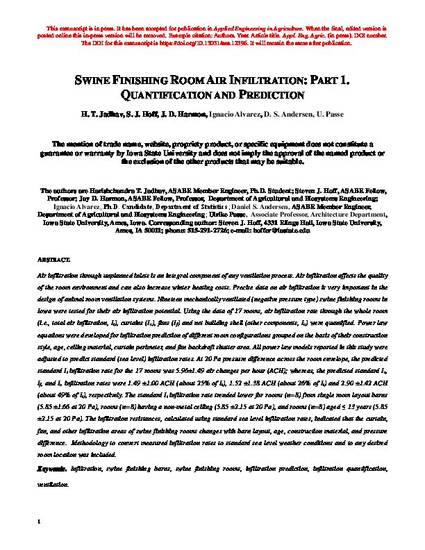
Air infiltration through unplanned inlets is an integral component of any ventilation process. Air infiltration affects the quality of the room environment and can also increase winter heating costs. Precise data on air infiltration is very important in the design of animal room ventilation systems. Nineteen mechanically ventilated (negative pressure type) swine finishing rooms in Iowa were tested for their air infiltration potential. Using the data of 17 rooms, air infiltration rate through the whole room (i.e., total air infiltration, It), curtains (Ic), fans (If) and net building shell (other components, Io) were quantified. Power law equations were developed for infiltration prediction of different room configurations grouped on the basis of their construction style, age, ceiling material, curtain perimeter, and fan backdraft shutter area. All power law models reported in this study were adjusted to predict standard (sea level) infiltration rates. At 20 Pa pressure difference across the room envelope, the predicted standard It infiltration rate for the 17 rooms was 5.96±1.49 air changes per hour (ACH); whereas, the predicted standard Ic, If, and Ioinfiltration rates were 1.49 ±1.00 ACH (about 25% of It), 1.52 ±1.38 ACH (about 26% of It) and 2.90 ±1.42 ACH (about 49% of It), respectively. The standard Itinfiltration rate trended lower for rooms (n=8) from single room layout barns (5.85 ±1.66 at 20 Pa), rooms (n=8) having a non-metal ceiling (5.85 ±2.15 at 20 Pa), and rooms (n=8) aged = 13 years (5.85 ±2.15 at 20 Pa). The infiltration resistances, calculated using standard sea level infiltration rates, indicated that the curtain, fan, and other infiltration areas of swine finishing rooms changes with barn layout, age, construction material, and pressure difference. Methodology to convert measured infiltration rates to standard sea level weather conditions and to any desired room location was included.
Available at: http://works.bepress.com/steven_hoff/151/

This is a manuscript of the article Jadhav, H. T., S. J. Hoff, J. D. Harmon, Igancio Alvarez, D. S. Andersen, and Ulrike Passe. "Swine Finishing Room Air Infiltration: Part 1. Quantification and Prediction." (2018). DOI: 10.13031/aea.12396. Posted with permission.